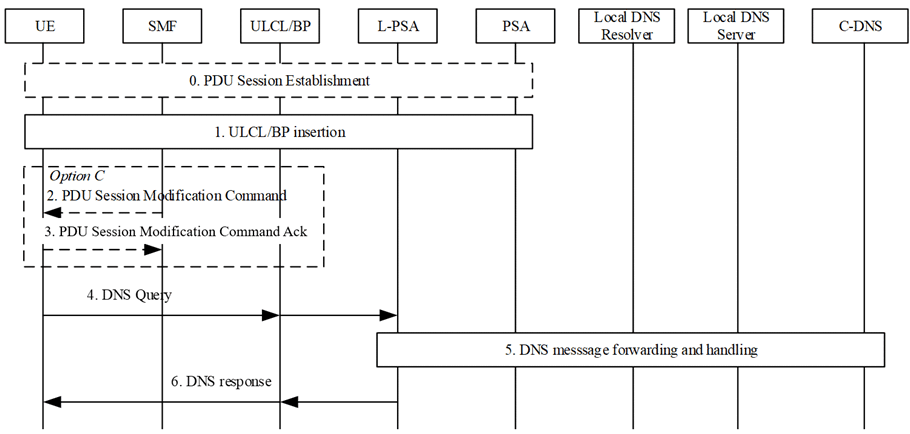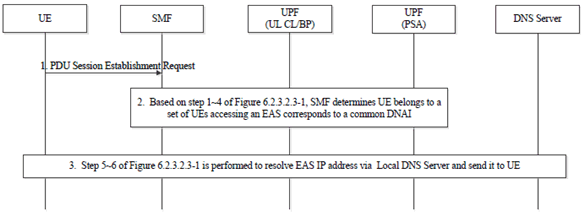Content for TS 23.548 Word version: 18.6.0
1…
4…
4.3
5…
6…
6.2.2.3…
6.2.3…
6.2.3.2.3…
6.2.3.2.5…
6.2.3.3…
6.3…
6.4…
6.5…
6.6
6.7…
6.7.2.4…
6.7.2.6…
6.7.3…
6.8…
7…
A
B…
F…
6.2.3.2.3 EAS Discovery Procedure with Local DNS Server/Resolver
6.2.3.2.4 Select common DNAI with Local DNS Server/Resolver for a set of UEs
...
...
6.2.3.2.3 EAS Discovery Procedure with Local DNS Server/Resolver p. 26
For the case that the DNS message is to be handled by Local DNS resolver/server, the DNS Query is routed to the Local DNS resolver/server corresponding to the DNAI where the L-PSA connects. The SMF selects the Local DNS server address based on the DNAI corresponding to the inserted local PSA, local configuration and based on EAS Deployment Information in AF request as specified in clause 6.2.3.4.2. Based on the operator's configuration, one of the following options may apply when UL CL/BP and Local PSA have been inserted (during or after PDU Session Establishment):
- Option C: The SMF configures the local DNS server to the UE as new DNS server. The SMF may indicate to the UE either that for the PDU Session the use of the EDC functionality is allowed or that for the PDU Session the use of the EDC functionality is required. In addition, the SMF also configures traffic routing rule on the UL CL (including e.g. Local DNS server address) or the BP (e.g. the new IP prefix @ Local PSA) to route traffic destined to the L-DN including the DNS Query messages to the L-PSA. The L-DNS server resolves the DNS Query either locally or recursively by communicating with other DNS servers.
- Option D: If the SMF has been configured that DNS Queries for an FQDN (range) query can be locally routed on the UL CL, then the subsequent DNS Queries for the FQDN (range) will be locally routed to a Local DNS server.

Step 0.
Steps 2 and 3 are performed for option C:
UE sends a PDU Session Establishment Request to the SMF as shown in step 1 of clause 4.3.2.2.1 of TS 23.502. The SMF retrieves the UE subscription information from the UDM (which may optionally include an indication on UE authorization for EAS discovery via EASDF) and checks if the UE is authorized to discover the EAS via EASDF. If not authorized, the actions related to EASDF in this procedure are skipped.
Step 1.
The SMF inserts UL CL/BP and Local PSA.
UL CL/BP/Local PSA insertion can be triggered by DNS messages as described in clause 6.2.3.2.2. Or, the SMF may pre-establish the UL CL/BP and Local PSA before the UE sends out any DNS Query message (e.g. upon UE mobility). In this case, the SMF includes the IP address of Local DNS Server in PDU Session Establishment Accept message as in step 11 of clause 4.3.2.2.1 of TS 23.502 or in a network initiated PDU Session Modification procedure. The UE configures the Local DNS Server as DNS server for that PDU Session.
The UL CL/BP and Local PSA are inserted or changed as described in TS 23.502. In the case of IPv6 multi-homing, the SMF may also send an IPv6 multi-homed routing rule along with the IPv6 prefix to the UE to influence the selection of the source Prefix for the subsequent DNS Queries as described in clause 5.8.2.2.2 of TS 23.501.
When the UL CL/BP and Local PSA are inserted or simultaneously changed, the SMF configure the UL CL/BP for DNS Query handling:
- For Option C, the SMF configures traffic routing rule on the UL CL (including e.g. Local DNS server address) or the BP (e.g. the new IP prefix @ Local PSA) to forward UE packets destined to the L-DN to the Local PSA. The packets destined to L-DN includes DNS Query messages destined to Local DNS Server.
Step 2.
If SMF decides to remove the UL CL/BP and Local PSA as defined in clause 4.3.5.5 of TS 23.502, e.g. due to UE mobility, the SMF sends a PDU Session Modification Command to configure the new address of the DNS server on UE (e.g. to set it to the address of EASDF).
If the UL CL/BP and Local PSA are inserted after PDU Session Establishment, the SMF sends PDU Session Modification Command (Local DNS Server Address) to UE.
If, based on operator's policy or UE's mobility, the Local DNS Server IP address in the local Data Network needs to be notified or updated to UE, the SMF sends PDU Session Modification Command (Local DNS Server Address) to UE.
Step 3.
The UE responds with PDU Session Modification Command Ack.
The UE configures the Local DNS Server as the DNS server for the PDU Session. The UE sends the following DNS Queries to the indicated Local DNS Server.
If EASDF was used as the DNS server for the PDU Session, the SMF may invoke Neasdf_DNSContext_Delete service to remove the DNS context in the EASDF.
For the Split-UE in the option C case, the new address of Local DNS Server cannot be provided to the TE or the TE OS from the MT, Annex C documents mitigations for this scenario.
Step 4.
If required (see clause 5.2.1), the application in the UE uses the EDC functionality as described in clause 6.2.4 to send the DNS Query to the DNS Resolver/DNS Server indicated by the SMF in Step 0. UE sends a DNS Query message. In the case of IPv6 multi-homing the UE selects the source IP prefix based on the IPv6 multi-homed routing rule provided by SMF.
Step 5.
The DNS Query message is forwarded to the Local DNS Server and handled as described in following:
Step 6.
- For Option C, the target address of the DNS Query is the IP address of the Local DNS Server. The DNS Query is forwarded to the Local DNS Server by UL CL/BP and Local PSA. The Local DNS Server resolves the FQDN of the DNS Query by itself or communicates with other DNS server to recursively resolve the EAS IP address.
- For Option D: The Local PSA sends the DNS traffic to the Local DNS Server that resolves the FQDN target of the DNS Query by itself or that communicates with a C-DNS server to recursively resolve the EAS IP address.
The Local PSA receives DNS Response message from Local DNS server, it forwards it to the UL CL/BP and the UL CL/BP forwards the DNS Response message to UE.
6.2.3.2.4 Select common DNAI with Local DNS Server/Resolver for a set of UEs |R18| p. 28
The following procedure is for selecting common DNAI with Local DNS Server/Resolver for set of UEs.

Step 1.
The UE sends a PDU Session establishment request to SMF as specified in step 0 of Figure 6.2.3.2.3-1.
Step 2.
The procedure in steps 1-4 of Figure 6.2.3.2.3-1 applies with following difference:
In step 1, the SMF determines UE belongs to a set of UEs accessing an EAS corresponds to a common DNAI based on traffic correlation indication and Traffic correlation ID in the PCC rule.
If the common DNAI is not available, the SMF notifies the NEF to determine the common DNAI as described in clause 6.2.3.2.7.
Once the common DNAI is available, SMF inserts or changes a Local PSA serving the common DNAI and selects local PSA and local DNS server corresponding to the common DNAI.
If the PDU session has been established and the PCC rule including updated common DNAI is provided to SMF, the SMF should reselect the local DNS server according to the common DNAI and configure the UE with new local DNS server in PCO using PDU session modification procedure.
Step 3.
The EAS information (e.g. EAS IP address) is resolved by Local DNS Server and sent the UE as described in steps 5-6 of Figure 6.2.3.2.3-1.